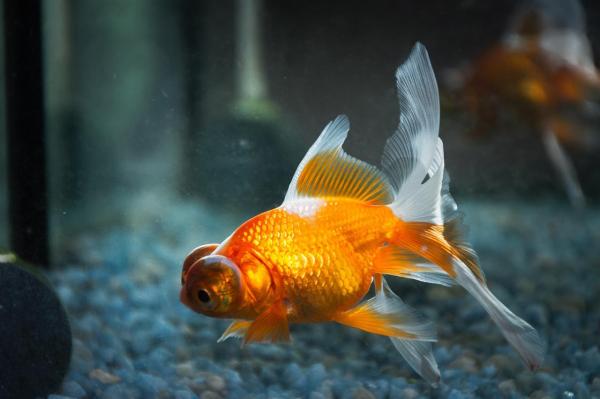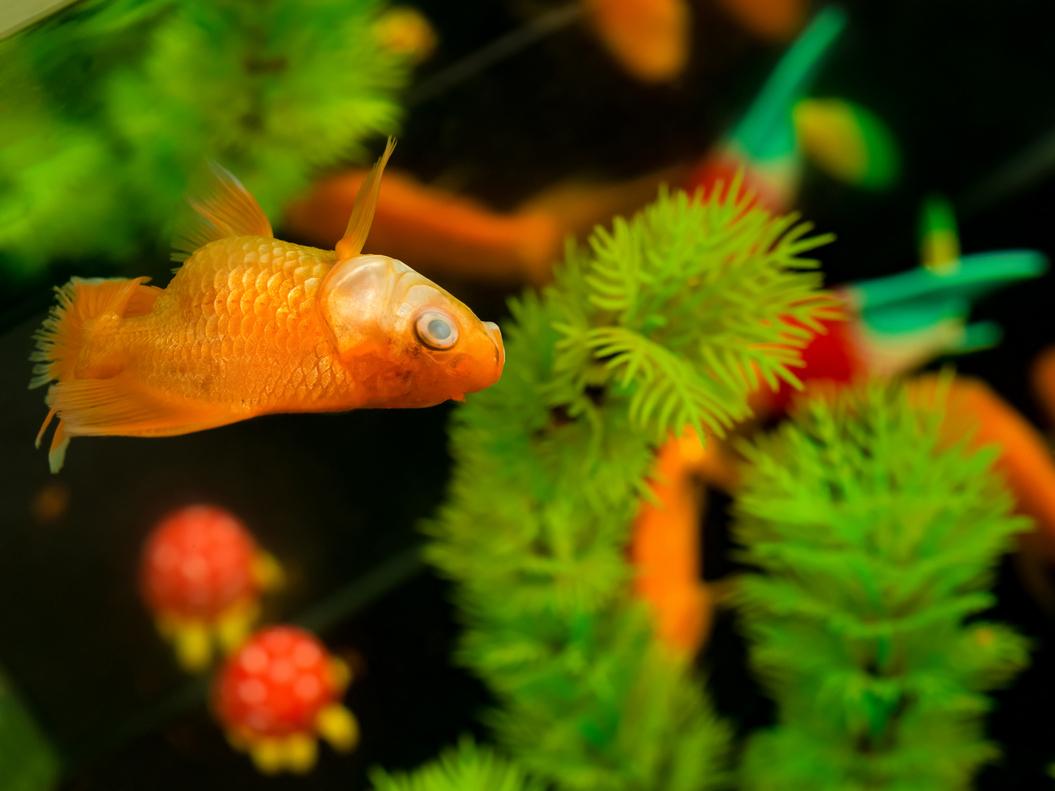My Fish is Swimming Sideways


Too many people thinking caring for fish is simple and doesn't involve much from us on our part. However, there are many factors we need to consider if we take on the responsibility of fish as pets. While terrestrial animals kept as pets have their own care needs, the aquatic environment of fish needs to be kept in a very careful balance. This environment also means treating health issues is even more complicated. Another difficulty is the fact that human-fish communication is severely limited. This makes even knowing when a fish is sick difficult to observe. This is why we need to be vigilant when we do spot possible symptoms.
In this AnimalWised article on my fish is swimming sideways, we look at the reasons for this this phenomenon. One of the most prevalent is swim bladder disease, but it is important to know other possible causes. This way we can know the best treatment options available.
Reasons my fish is laying on its side
There are several reasons why a fish may be seen swimming on its side. The causes are related to certain diseases and health problems. Unfortunately, research into fish disease is relatively limited, especially compared to other companion animals such as dogs and cats. Part of the reason is that some people do not even consider fish as ‘pets’, although this is debate we won't get into here.
If your fish is swimming sideways, it is possibly one of the following issues:
Swim bladder disease
Most domestic bony fish have an anatomical structure known as a swim bladder. This organ is a membranous sac which is located under the spine. While a bladder is an organ which can be filled with fluid or air, the function of a swim bladder is not the same as a urinary bladder. The swim bladder is responsible for different functions depending on the species, but the main function is bouyancy.
The anatomy of fish differ according to species and type. Some connect the swim bladder to the digestive tract, allowing them to intake and release air differently. Others uses a special gland to allow gas to enter the bladder. However, all use the bladder to contract or expand according to the ambient pressure and maintain a certain depth under water.
Diseases of the swim bladder are often caused by inhospitable conditions in the fish tank. For example, if the filter is insufficient, impurities in the water can lead to problems. Trauma or other risks can affect the swim bladder also. This is most common in bulbous fish such as the goldfish, but it can occur in any species with a swim bladder.
In addition to observing the fish swimming sideways, it is possible to look at other symptoms of swim bladder disease. These include the fish being more bloated than usual or they have stopped eating.

Gastrointestinal parasites
Also there are many different symptoms of parasitosis in fish, but the fish swimming on sideways or on its side is perhaps the most obvious. The fish tends to retract one of its fins which affects its stability and agility in the water. The most common intestinal parasites in fish are from the genus Hexamita. Once treatment is enacted, the prognosis is generally favorable. The fish may return to normal within a few days of treatment. This will depend on the stage of infestation.
Characteristic signs of hexamitiasis other than fish swimming on their side include:
- Anorexia[1]
- Dark coloration
- Fecal psuedo cast
- Swollen belly
If the hexamitiasis develops far enough, the epithelium of the fish's intestines can become necrotic[2]. This is potentially fatal for the fish.
Bacterial infections
Some diseases caused by bacteria have swimming on their side as a symptom. However, this will only be the case when the bacterial disease has progressed to an advanced stage. These pathologies are generally more serious than a parasitical infestation, but it will also depend on the type of bacteria or parasite. They are life threatening and require special care from the owner.
Bacterial infections differ according to the bacteria responsible. Therefore, treatment and prognosis are to be assessed on a case by case basis. The affect the disease has on the fish's ability to swim will also depend on the individual.
Some fish owners may see their fish swimming in different directions, not just on their side. If a fish is swimming vertically or upside down, it is still likely due to one of the above issues. The problem will depend on how the bladder is affected and where it lies in the fish's anatomy. E.g. if gas collects and the bladder is located lower on the fish, the result will be the fish swimming upside down.
Fish swimming on their side treatment
To stop the fish from swimming on its side, the treatment will depend on the cause. However, diagnosis of the problem will not be easy. Even your closest veterinarian may struggle with treatment options. They should be able to point you in the direction of a specialist who is able to treat the fish. The most common treatments include:
Treatment of bacterial infections
Generally, in the case of bacterial infections, the use of antibiotics is the best option. When we find that our fish has a bacterial infection, we will take them to a fish specialist. They will need to assess the fish's health status and implement the correct course of treatment. We need to follow their instructions carefully, otherwise the treatment has less chance of being effective. This is the case even if the fish appears to recover.
Another aspect of treating bacterial infections in fish is a practical one. It is likely the fish has been infected by the bacteria thanks to the quality of the water in the tank or the food which it eats. This means you will need to assess the water quality, filter efficacy, food type and pretty much everything else about their care needs. You will also need to pay close attention to any other fish which may be in the aquarium. The same bacteria may have infected them since they share the same water.
Treatment of swim bladder disease
Treatment of swim bladder is difficult, but it may require invasive techniques. While fish surgery is a relatively uncommon practice, it does occur. Some of the problems faced with surgical intervention include providing safe anesthesia and the difficulty of providing appropriate post-operative treatment[3]. However, if surgical treatment is possible and affordable, it may be carried out to help the affected organs.
It is possible that lifestyle changes may be able to treat swim bladder disease and stop the fish from swimming on its side or upside down. However, what these changes may be will depend on the individual fish and will need to be decided by a specialist. It is also possible that a 24-48 hour fast might help rectify the situation as accumulated gases can be dispelled.
There are sources which suggest giving the fish green pea will cure swim bladder in fish, but there are no peer-reviewed studies to confirm this. In fact, it is possible that this could make things worse, depending on the cause.
Treatment of parasites
For cases of intestinal parasites, it is recommended the fish is put under strict supervision by a veterinarian. They will be able to perform appropriate deworming treatment in an ‘aquarium hospital’. Any other fish in the original aquarium will also need to be monitored to see if the parasites have spread. Treatment will also depend on the fish species. For example, parasites prone to affecting betta fish may not be the same ones affecting angel fish.

Is the fish dying?
Whether or not the fish can recover will depend on the severity of the condition. Beforehand, it was generally thought that swim bladder disease would likely be fatal in most cases. However, awareness and development of treatment mean we can achieve a better prognosis.
Difficulties affecting prognosis include the time it takes to get to treatment and the treatment options available in your area. It will also be up to the fish owner how to treat them since often procedures and treatment are prohibitively expensive. The types of bacteria and parasites will also have a bearing on the prognosis.
This article is about what happens when your fish is swimming sideways. If the fish is floating on its side, but not moving at all, it is possible they are dead. However, some fish may simply not be moving, but are still alive. A specialist will be able to determine if this is the case.
This article is purely informative. AnimalWised does not have the authority to prescribe any veterinary treatment or create a diagnosis. We invite you to take your pet to the veterinarian if they are suffering from any condition or pain.
If you want to read similar articles to My Fish is Swimming Sideways, we recommend you visit our Other health problems category.
1. Uldal, A., & Buchmann, K. (1996). Parasite host relations: Hexamita salmonis in rainbow trout Oncorhynchus mykiss. Diseases of Aquatic Organisms, 25, 229-231.
https://www.int-res.com/articles/dao/25/d025p229.pdf
2. Timur, G., et al. (2009). A histopathological study of Hexamitiasis in farmed rainbow trout (Oncorhynchus ykiss) fry in Turkey. Bull. Eur. Ass. Fish Pathol., 29(3), 104.
https://pdfs.semanticscholar.org/e122/74dde0fd8ecce57ec5e28341d9a445d3bdf4.pdf
3. Murray, M. J. (2002). Fish surgery. Seminars in Avian and Exotic Pet Medicine, 11(4), 246-257.
https://doi.org/10.1053/saep.2002.126571
- Cousseau, M. (2010). Fundamental aspects of Ichthyology. EUDEM editorial.







